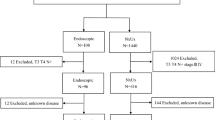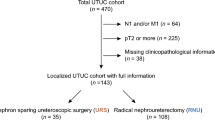Abstract
Purpose
Patients undergoing endoscopic management for upper tract urothelial carcinoma often progress to definitive therapy with radical nephroureterectomy. This study examined the rate of progression as well as risk factors for transitions in treatment over time.
Methods
Retrospective review at two institutions identified patients undergoing endoscopic management for upper tract urothelial carcinoma. Patients were assessed for progression to radical nephroureterectomy. Baseline characteristics were compared using Chi square analysis. Kaplan–Meier method analyzed the probability of patients not progressing to radical nephroureterectomy. Cox proportional hazards identified factors associated with progression to radical nephroureterectomy.
Results
Eighty-one patients had endoscopic management alone and 89 progressed to radical nephroureterectomy. The two groups had similar age, histories of bladder cancer, and Charlson comorbidity index. Positive urinary cytology, ureteroscopic visualization, and biopsy grade were higher in those progressing to RNU (p < 0.001). Hazard modeling demonstrated higher rates of progression to radical nephroureterectomy with positive biopsy (HR 11.8, 95% CI 2.4–59.5, p = 0.003) or visible lesion on ureteroscopy (HR 8.4, 95% CI 3.0–23.9, p < 0.001). Patients with a higher Charlson comorbidity index were less likely to have radical nephroureterectomy. On Kaplan–Meier modeling, the probability of not undergoing radical nephroureterectomy at 2 years and 5 years was 50% and 20%, respectively.
Conclusions
Patients who progress to radical nephroureterectomy after endoscopic management have fewer comorbid conditions and changes in disease status including visible lesions on ureteroscopy and positive biopsies. The high rate of progression to radical nephroureterectomy reinforces the need for long-term follow-up of these patients.

Similar content being viewed by others
References
Babjuk M, Oosterlinck W, Sylvester R (2012) EAU guidelines on non-muscle-invasive urothelial carcinoma of the bladder, the 2011 update. Actas Urológicas. https://doi.org/10.1016/j.acuroe.2011.12.007
Margulis V, Shariat SF, Matin SF, Kamat AM, Zigeuner R, Kikuchi E, Lotan Y, Weizer A, Raman JD, Wood CG, The Upper Tract Urothelial Carcinoma Collaboration (2009) Outcomes of radical nephroureterectomy: a series from the upper tract urothelial carcinoma collaboration. Cancer 115(6):1224–1233. https://doi.org/10.1002/cncr.24135
Abouassaly R, Alibhai SMH, Shah N, Timilshina N (2010) Troubling outcomes from population-level analysis of surgery for upper tract urothelial carcinoma. Urology 76:895–901
Roupret M, Babjuk M, Comperat E, Zigeuner R, Sylvester RJ, Burger M, Cowan NC, Bohle A, Van Rhijn BWG, Kaasinen E, Palou J, Shariat SF (2015) European Association of Urology Guidelines on upper urinary tract urothelial cell carcinoma: 2015 update. Eur Urol 68(5):868–879. https://doi.org/10.1016/j.eururo.2015.06.044
Roupret M, Colin P, Yates DR (2014) A new proposal to risk stratify urothelial carcinomas of the upper urinary tract (UTUCs) in a predefinitive treatment setting: low-risk versus high-risk UTUCs. Eur Urol 66(2):181–183. https://doi.org/10.1016/j.eururo.2013.12.007
Huang WC, Levey AS, Serio AM, Snyder M, Vickers AJ, Raj GV, Scardino PT, Russo P (2006) Chronic kidney disease after nephrectomy in patients with renal cortical tumours: a retrospective cohort study. Lancet Oncol 7(9):735–740. https://doi.org/10.1016/S1470-2045(06)70803-8
McKiernan J, Simmons R, Katz J, Russo P (2002) Natural history of chronic renal insufficiency after partial and radical nephrectomy. Urology 59(6):816–820
Zini L, Perrotte P, Capitanio U, Jeldres C, Shariat SF, Antebi E, Saad F, Patard JJ, Montorsi F, Karakiewicz PI (2009) Radical versus partial nephrectomy: effect on overall and noncancer mortality. Cancer 115(7):1465–1471. https://doi.org/10.1002/cncr.24035
Capitanio U, Terrone C, Antonelli A, Minervini A, Volpe A, Furlan M, Matloob R, Regis F, Fiori C, Porpiglia F, Di Trapani E, Zacchero M, Serni S, Salonia A, Carini M, Simeone C, Montorsi F, Bertini R (2015) Nephron-sparing techniques independently decrease the risk of cardiovascular events relative to radical nephrectomy in patients with a T1a–T1b renal mass and normal preoperative renal function. Eur Urol 67(4):683–689. https://doi.org/10.1016/j.eururo.2014.09.027
Yakoubi R, Colin P, Seisen T, Leon P, Nison L, Bozzini G, Shariat SF, Roupret M (2014) Radical nephroureterectomy versus endoscopic procedures for the treatment of localised upper tract urothelial carcinoma: a meta-analysis and a systematic review of current evidence from comparative studies. Eur J Surg Oncol 40(12):1629–1634. https://doi.org/10.1016/j.ejso.2014.06.007
Seisen T, Peyronnet B, Dominguez-Escrig JL, Bruins HM, Yuan CY, Babjuk M, Bohle A, Burger M, Comperat EM, Cowan NC, Kaasinen E, Palou J, van Rhijn BW, Sylvester RJ, Zigeuner R, Shariat SF, Roupret M (2016) Oncologic outcomes of kidney-sparing surgery versus radical nephroureterectomy for upper tract urothelial carcinoma: a systematic review by the EAU non-muscle invasive bladder cancer guidelines panel. Eur Urol. https://doi.org/10.1016/j.eururo.2016.07.014
Cutress ML, Stewart GD, Zakikhani P, Phipps S, Thomas BG, Tolley DA (2012) Ureteroscopic and percutaneous management of upper tract urothelial carcinoma (UTUC): systematic review. BJU Int 110(5):614–628. https://doi.org/10.1111/j.1464-410X.2012.11068.x
Seisen T, Colin P, Rouprêt M (2015) Risk-adapted strategy for the kidney-sparing management of upper tract tumours. Nat Rev Urol 12(3):155–166. https://doi.org/10.1038/nrurol.2015.24
Elliott DS, Blute ML, Patterson DE, Bergstralh EJ, Segura JW (1996) Long-term follow-up of endoscopically treated upper urinary tract transitional cell carcinoma. Urology 47(6):819–825. https://doi.org/10.1016/S0090-4295(96)00043-X
Suh RS, Faerber GJ, Wolf JS (2003) Predictive factors for applicability and success with endoscopic treatment of upper tract urothelial carcinoma. J Urol 170(6 Pt 1):2209–2216. https://doi.org/10.1097/01.ju.0000097327.20188.c1
Acknowledgements
Funding was provided in part by the Sidney Kimmel Center for Prostate and Urologic Disease.
Funding
K08DK097302-01A1, UL1 TR000448, R24 HS19455, KM1CA156708, P30 CA008748, Sidney Kimmel Center for Prostate and Urologic Disease.
Author information
Authors and Affiliations
Corresponding author
Additional information
Publisher's Note
Springer Nature remains neutral with regard to jurisdictional claims in published maps and institutional affiliations.
Rights and permissions
About this article
Cite this article
Mohapatra, A., Strope, S.A., Liu, N. et al. Importance of long-term follow-up after endoscopic management for upper tract urothelial carcinoma and factors leading to surgical management. Int Urol Nephrol 52, 1465–1469 (2020). https://doi.org/10.1007/s11255-020-02439-5
Received:
Accepted:
Published:
Issue Date:
DOI: https://doi.org/10.1007/s11255-020-02439-5




